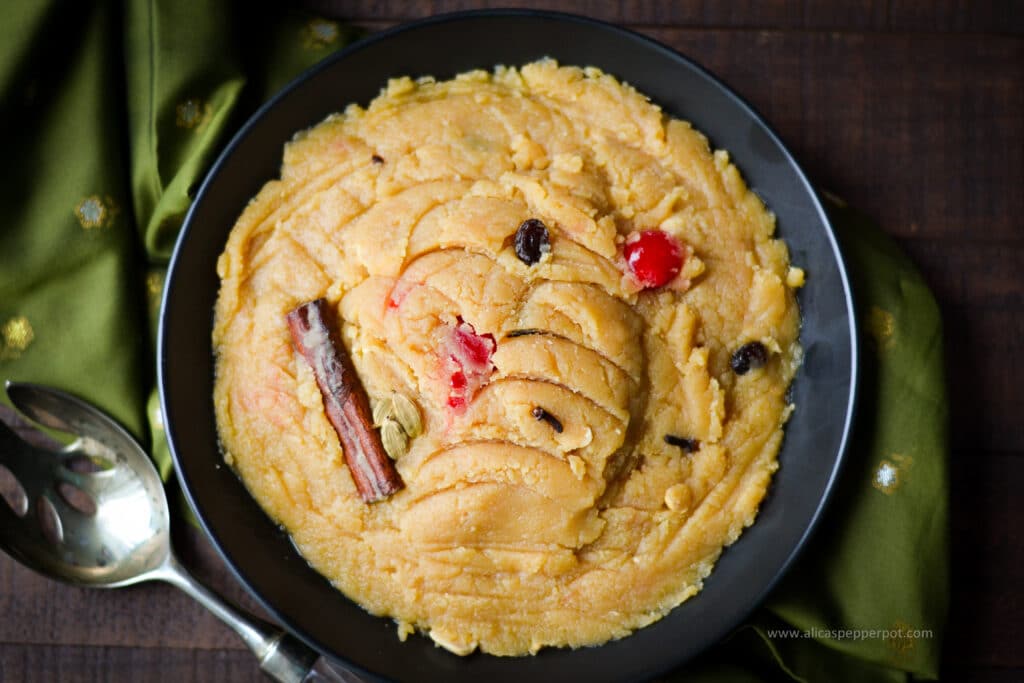
During the holy month of Ramadan, Muslims around the globe undergo a period of daily fasting. It's a time for spiritual enlightenment and purification. As the month comes to a close, celebrations for Eid commence. Like many holidays, food plays an important role in this festivity. Coming from a family that is mixed with Christians, Hindus, and Muslims, I was always exposed to the various culinary traditions of each faith.
I remember having a delicious sweet and smooth pudding at my aunty Bibi's house, known as sirnee. It resembles what Guyanese Hindus know as parsad, but there are slight differences in technique and ingredients. Both parsad and sirnee are essentially what other cultures would term as halwa. The term halwa, is used broadly to describe different types of semi-solid reductions based from either flour, nuts, or grains. Some varieties are smooth and soupy; others, firm and dense. I would say sirnee is somewhere in between being firm and semi-soft.
Meet Rosh
Today's blog post is very special because my friend Rosh is sharing her mother's way of making sirnee and also memories of this dish growing up as a young girl. I met Rosh on Instagram. She messaged me one day and we began chatting. I discovered that she is a paper florist and pastry chef! I was amazed at how pretty her creations were and instantly became a fan. We randomly started chatting about food one day and I also learned that she is a practicing Muslim. I immediately and shamelessly asked her for a sirnee recipe.
Recipe Review
I have been testing sirnee recipes since last year and I just couldn't get it right. Rosh told me her mother was a master at it and that she would measure out the ingredients so I could test it. I tried the recipe over the weekend, and um, it was ah-mazing! Finding the balance between liquid and dry ingredients for this sweet is critical. Too much liquid and it ends up gooey and sticky; too little and it's crumbly and stiff. Rosh's recipe was spot on. It was velvety smooth and perfectly sweetened! She does add eggs to her recipe and those of you who have followed the blog over the years know how funny I am about things tasting "eggy," so I was hesitant when I saw that the recipe contained eggs. Let me tell you, the sirnee turned out so fluffy and rich with no eggy aftertaste. Thank you Rosh for a fantastic recipe, I know anyone who tries it will love it as much as I did!

Q&A with Rosh
- If you had to describe sirnee to a person who has never tasted it, what would you say?
The taste reminds me of edible cookie dough, but with a little more character. It tastes like a story of some kind - a buttery setting, nutty and sweet interludes. But at a snail's pace, it melts on the tongue. The texture offers a heightened level of appreciation with its smooth consistency, crunchy walnuts, and chewy raisins and cherries.
2. When does your family typically make sirnee? Only during Ramadan and Eid?
It doesn’t just stop at Ramadan and Eid for us! We make it for non-religious traditional get-togethers, weddings, and birthday celebrations. It’s always a joy to witness everyone perk up after having seen sirnee make its grand debut on the dessert table!
3. What is the process like to make this sweet dish?
We begin by melting the butter. After inserting spices of cloves, cardamom, and cinnamon, a certain flavor and fragrance is induced when placed over heat. Once the butter melts, we add flour to form a roux. Then cue the elbow-grease, it’s time for stirring! After which a sweetened egg-milk mixture is added to the roux -- along with nuts, cherries, and raisins. And with that, you’ve made a sophisticated yet simple dish!
4. Do you have any fond memories of this dish from growing up?
Absolutely! My favorite would be Eid mornings! My grandmother, mother, and sister would rise as early as 5:30am to prepare fresh treat bags for our friends and relatives. It was full-fledged factory style! Grandma laid out all the sweets and Mum would scoop the sirnee into a bag. The bag was always clear, chosen with intention, so that our friends and relatives could appreciate a window into our labor of love. My sister would then tie the bags and I would place them in a cute box with a personalized, handwritten “Eid Mubarak!” message. Dad would come downstairs sometime after we started and would liven the mood even further by playing his favorite Qawwali songs. It was always his tradition to greet us all with little gifts. I specifically remember a moment where he became emotional because he was so proud of us, all having endured an entire month of fasting. These moments of love, stored in a single bite of sirnee.
5. What makes your family's recipe different from others?
My mother. After many trials, many errors, and many years of consistent attempts, she created her one, perfect recipe. I am honored to have that passed down to me. It serves not only as a tradition in our household, but also as a source of inspiration for other treats.
6. Do you know of any differing techniques/ingredients for sirnee? If so, can you share what's different?
I do know that where some may use evaporated milk, others may also add ingredients like condensed milk and water to their sirnee. But do remember, everyone’s sirnee will always be different in some way -- this is what makes it so special.
7. Can you share a cooking tip or two for making sirnee?
a. Prep thoroughly beforehand and keep everything in arm’s reach beside you when you’re at the stove – including the dish you’re going to transfer it to when it’s done. You do not want to be scrambling for ingredients once you’re stationed at the stove because: 1. The main task in the entire process is stirring and 2. You need to keep an eye on what you’re doing. The sirnee can burn and you will have to start all over again!
b. Use a leveled pan for even heat distribution/cooking.
c. If it’s your first time making sirnee, perhaps do it with a partner. The help comes in handy, and it’s loads of fun for everyone!
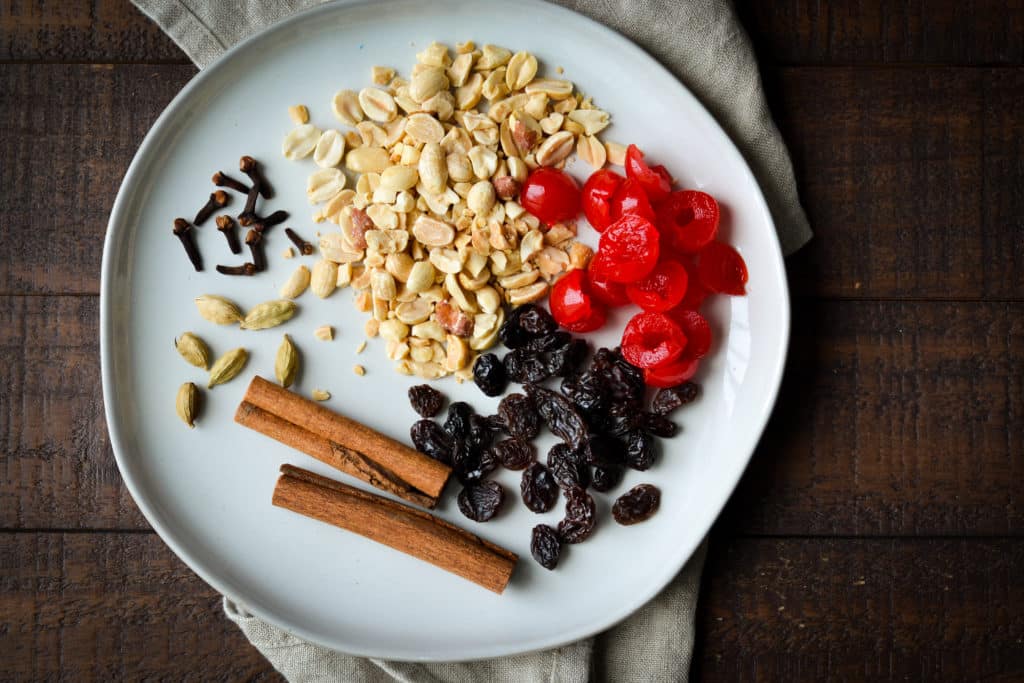
The process
After flour butter mixture begins to crumble and turn golden brown, add liquid (3rd pic) and continue to stir until sirnee leaves the sides of the pot.

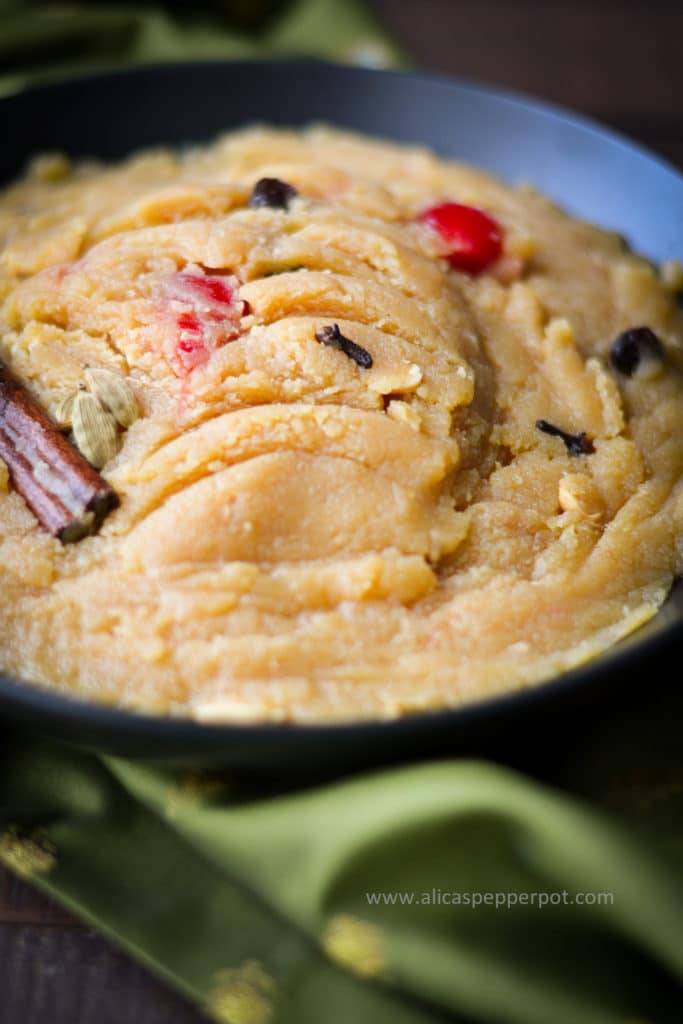
Sirnee: Trinidad vs. Guyana
The term sirnee in Trinidad and Guyana refers to two different things, so to eliminate any confusion I reached out to Reshmi from Taste of Trini to help provide some clarification (check out her Youtube channel by the way, mouthwatering!). Reshmi attended a Muslim primary school in Trinidad so I knew she'd be the perfect person to ask! In Trinidad, Muslims use the term sirnee to broadly describe the snacks/sweets or food given after masjid service has concluded. Guyanese Muslims know sirnee as a single dish, as in the recipe in this post. Trinidadian Muslims make something similar to Guyanese sirnee, but it is called rice halwa. Rice halwa is made with rice flour and a liquid component along with cherries and raisins. It is cooked down then formed into little balls and sometimes served in a dosti roti.
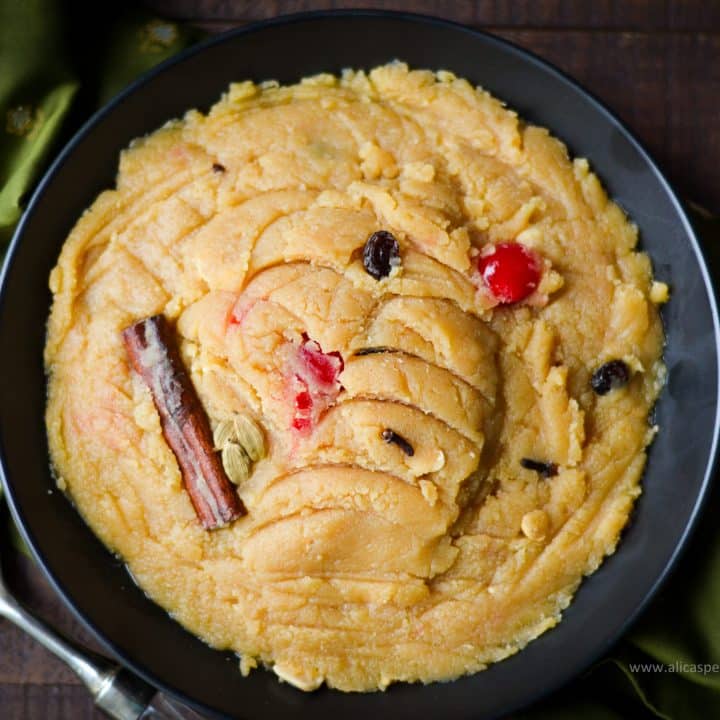
Rosh’s Sirnee Recipe
Ingredients
- 2 eggs
- 1 lb. sugar (2 level cups)
- 1 12oz can evaporated milk
- 2 tsp. essence (mixed or vanilla)
- 1 lb. butter
- 10 whole cloves
- 1-2 cinnamon sticks
- 6 cardamom pods
- 1 lb. all-purpose flour (3 ⅓ level cups)
- 1 tsp. ground cardamom
- ½ tsp. nutmeg
- Cherries (optional)
- Raisins (optional)
- Chopped walnuts or raw peanuts (optional)
- *cherries/raisins/nuts can use an eyeball measure, it’s just mainly what you prefer
Instructions
- Combine raisins, nuts, and cherries. Set aside.
- In a separate bowl, beat eggs, evaporated milk, sugar, and essence. Whisk until sugar has dissolved. Set aside.
- On low heat, in a flat-bottom pot, melt butter. Add cloves, cinnamon sticks, and whole cardamom.
- Once butter is melted, add flour and continuously stir for 7 to 10 minutes. *This process is like making a roux! It is the most taxing part of the entire procedure, gotta keep stirring so as to not burn the mixture.
- Keep stirring until the ‘roux’ becomes more paste-like and loose (somewhat resembles curds), then add ground cardamom and nutmeg and give it a stir for even combining. *At this point, the mixture looks slightly golden brown. This is another way to know you’ve completed this step.)
- Turn heat to High and pour in egg-milk mixture. Continue the stir! As you do, the mixture will look lumpy but the milk will evaporate and the mixture will smooth out and homogenize.
- Add cherry-raisin-nut mixture and stir vigorously for 1-2 minutes.
- The sirnee is done when you notice it pulling away from the sides of the pan. You can then transfer it from the heat to serving dish.
- *It will seem super moist just off the stove, but as it cools it will dry up.
Notes
Orange soda, 7up, or pineapple soda may be substituted for part of the liquid content. Eggs and peanuts may be omitted.
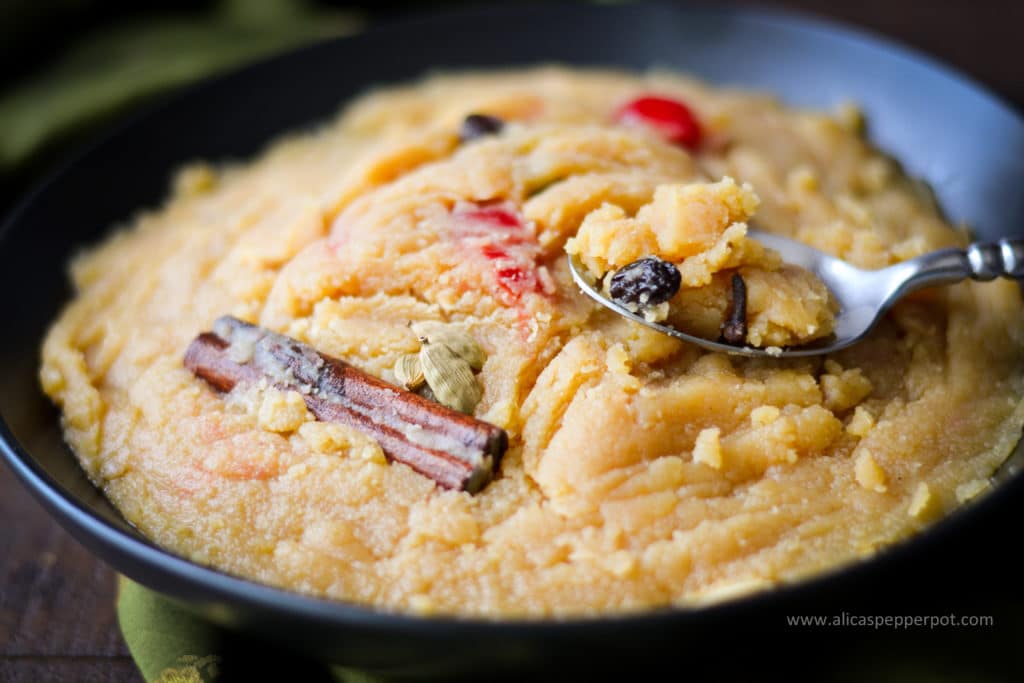


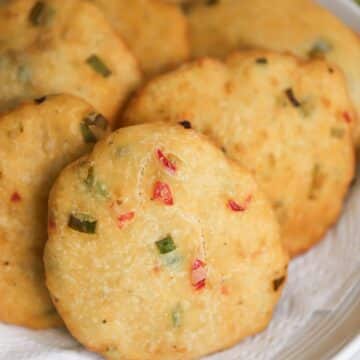
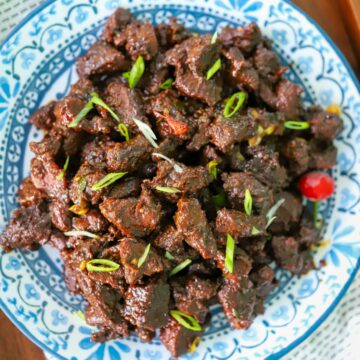
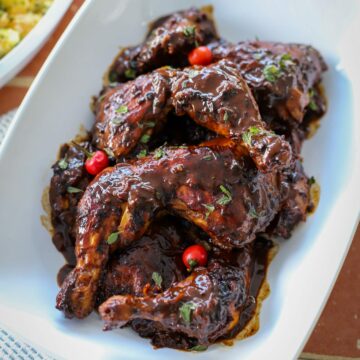
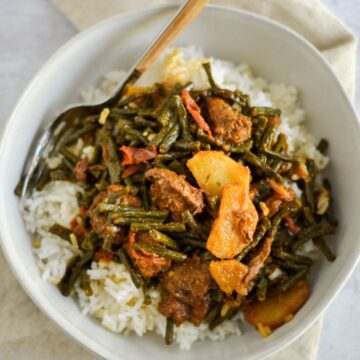
Ronica says
Thank you for posting. I want to try this but want to omit the eggs. Do u think it will come out good without it. And how much soda can I use without making it too moist.
Thanks
R. Aziz says
It will definitely come out good. My family never made it with eggs and it’s always perfect:)
Shafe Balgobin says
Our family never use eggs an it comes out perfect an tasty, never heard of the eggs in sirnie recipe.
Alica says
Hi Ronica,
Yes you can absolutely make it without eggs. My cousin's mother-in-law makes it without eggs and we enjoy it so much!
Kami | Life with Kami says
I'm definitely going to try this recipe. Thanks for sharing.
Geeta says
looks yummy...will definitely try this.
Shanta says
Looks fantastic..a friend showed me how to make it many years ago minus the eggs.. I will definitely try this with the eggs and see how it turns out.
Lalita says
Hi Alica,
Do you use salted or unsalted butter?
Thanks!
Shantie A says
Hi Alicia,
Thank you and your friend Rosh for this great Sirnee recipe. I have one question though, so instead of using whole Cloves & Cinnamon, could I subtitute the powder and if so, what would be the exact measurements?
Your response would be greatly appreciated.......Thanks!
Shantie A.
Gajanand says
Sirnee is the same we call it in Central India. Sheera is another name. I like the combination of spices, we usually only use only cardamom. We don't use eggs for Prasad.
Cynthia says
Thanks for this post Alcia and thanks to Rosh for sharing her family's recipe. Someone asked about not using the eggs, and you said that it can be made without the eggs (as you and I know), but tell me this - is there a discernible variance in texture or mouthfeel of the sirnee with the eggs than without? Definitely want to make it this year for Eid. Thanks!
Alica says
Hi Cynthia!
I would have to say yes, adding eggs makes the texture velvety in your mouth. It gives it a very rich taste. I was able to recognize that only after the sirnee was cool. The "mouthfeel" with the eggs is biggest difference with sirnee and parsad. Would love to catch up soon!
Cynthia says
Thanks for your prompt, detailed response Alicia! Truly appreciated.
Yes, me too, let's catch up soon. Love the new look and feel of the site. Talk soon! Hugs
Amelia says
Hi! Is there a way to make this recipe without the eggs? Please let me know, thank you!
Amelia says
Oh wait! I just saw the comments! Will try it out 🙂
Jay says
This reminds me of my childhood so much <3
Yasmin says
I tried it today for the first time. I'm Muslim but don't eat sweets so I don't make anything sweet. However mine came out a bit not dry but not as soft as my mom's. Could it be because it needed some more milk?
Alica says
It can become dry if it has dried down too much toward the end. Add a little more milk next time, it might help! 🙂
Anita says
One can of evaporate milk won’t do. I used 3 cans.
Vaideeka says
I made this for my family a few minutes ago and got some good compliments, thanks Rosh and Alicia! For me personally though, I was always used to sirnee having a bit of a grainy texture along with a little spice from ginger and a bit of a bubbly/fluffy consistency..I would assume the grainy texture comes from using cream of wheat, little bit of spice from adding fresh ginger and obviously a little orange/cream soda for the bubbly fluff and extra flavor? I halved this recipe and it was perfect measurement wise. The nuts definitely added a nice crunch to go with the smooth texture. I liked it and my family liked it, we Will most definitely be making this recipe again and I will try it with a little cream of wheat, cream/orange soda and fresh ginger and let you know if I got the texture and flavor I was looking for. Thanks so much again!
katrine says
im enjoying your blog so much ..I spent two days reading actually alllll your recipe. will dif be trying out some. I never liked following recipe online because it never comes out good... I rather see how people make it first and then try it out, but you wrote everything so simple and in detailed here. thank you!
Sabrina says
Hmmm the update with the egg makes the recipie unusable for Hindu puja. I loved your old recipe and because I don't make parsad often Id always come back to this recipe to make it for Diwali and holi and now I can't. Could you make add the other one back too?. So those of us who want to
make it eggless can.
Alica says
Hi Sabrina,
This recipe was never intended for Hindu poojas. It was made for Eid by request of my Muslim followers, in which case this can be made with or without eggs. The recipe you’re looking for is still on my blog, search "flour parsad" and it should pop up. If you have any trouble, please email me and I will happily send you the link. Hope this helps!